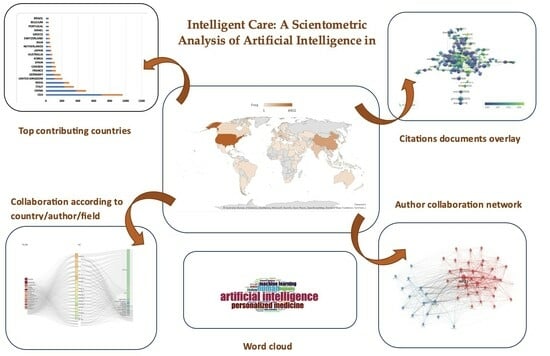Intelligent Care: A Scientometric Analysis of Artificial Intelligence in Precision Medicine
Abstract
:1. Introduction
2. Methodology
2.1. Data Collection
2.2. Data Processing and Normalization
2.3. Scientometric Analysis
3. Results
3.1. Publication Trends over Time
3.2. Geographical Distribution and Institutional Contributions
3.3. Citation Patterns and Influential Research
3.4. Co-Citation Networks and Thematic Clusters
3.5. Emerging Terms over Time
4. Discussion
Author Contributions
Funding
Institutional Review Board Statement
Informed Consent Statement
Data Availability Statement
Acknowledgments
Conflicts of Interest
Abbreviations
| AI | Artificial Intelligence |
| CSV | Comma-Separated Values |
| DOI | Digital Object Identifier |
| RIS | Research Information System |
References
- Johnson, K.B.; Wei, W.Q.; Weeraratne, D.; Frisse, M.E.; Misulis, K.; Rhee, K.; Zhao, J.; Snowdon, J.L. Precision medicine, AI, and the future of personalized health care. Clin. Transl. Sci. 2021, 14, 86–93. [Google Scholar] [CrossRef] [PubMed]
- Ahmed, Z.; Mohamed, K.; Zeeshan, S.; Dong, X. Artificial intelligence with multi-functional machine learning platform development for better healthcare and precision medicine. Database 2020, 2020, baaa010. [Google Scholar] [CrossRef] [PubMed]
- Goetz, L.H.; Schork, N.J. Personalized medicine: Motivation, challenges, and progress. Fertil. Steril. 2018, 109, 952–963. [Google Scholar] [CrossRef] [PubMed]
- Gray, I.D.; Kross, A.R.; Renfrew, M.E.; Wood, P. Precision medicine in lifestyle medicine: The way of the future? Am. J. Lifestyle Med. 2020, 14, 169–186. [Google Scholar] [CrossRef]
- Zahra, M.A.; Al-Taher, A.; Alquhaidan, M.; Hussain, T.; Ismail, I.; Raya, I.; Kandeel, M. The synergy of artificial intelligence and personalized medicine for the enhanced diagnosis, treatment, and prevention of disease. Drug Metab. Pers. Ther. 2024, 39, 47–58. [Google Scholar] [CrossRef]
- Sahu, M.; Gupta, R.; Ambasta, R.K.; Kumar, P. Artificial intelligence and machine learning in precision medicine: A paradigm shift in big data analysis. Prog. Mol. Biol. Transl. Sci. 2022, 190, 57–100. [Google Scholar]
- Rane, N.; Choudhary, S.; Rane, J. Machine Learning and Deep Learning: Methods, Techniques, Applications, Challenges, and Future Research Opportunities. In Trustworthy Artificial Intelligence in Industry and Society; Deep Science Publishing: San Francisco, CA, USA, 2024. [Google Scholar] [CrossRef]
- Rane, N.L.; Paramesha, M.; Choudhary, S.P.; Rane, J. Machine learning and deep learning for big data analytics: A review of methods and applications. Partn. Univers. Int. Innov. J. 2024, 2, 172–197. [Google Scholar] [CrossRef]
- Sarkar, C.; Das, B.; Rawat, V.S.; Wahlang, J.B.; Nongpiur, A.; Tiewsoh, I.; Lyngdoh, N.M.; Das, D.; Bidarolli, M.; Sony, H.T. Artificial intelligence and machine learning technology driven modern drug discovery and development. Int. J. Mol. Sci. 2023, 24, 2026. [Google Scholar] [CrossRef]
- Sherani, A.M.; Khan, M.; Qayyum, M.U.; Hussain, H.K. Synergizing AI and Healthcare: Pioneering Advances in Cancer Medicine for Personalized Treatment. Int. J. Multidiscip. Sci. Arts 2024, 3, 270–277. [Google Scholar] [CrossRef]
- Ding, X.; Yang, Z. Knowledge mapping of platform research: A visual analysis using VOSviewer and CiteSpace. Electron. Commer. Res. 2022, 22, 787–809. [Google Scholar] [CrossRef]
- Singh, V.K.; Banshal, S.K.; Singhal, K.; Uddin, A. Scientometric mapping of research on ‘Big Data’. Scientometrics 2015, 105, 727–741. [Google Scholar] [CrossRef]
- Yao, Q.; Chen, K.; Yao, L.; Lyu, P.H.; Yang, T.A.; Luo, F.; Chen, S.Q.; He, L.Y.; Liu, Z.Y. Scientometric trends and knowledge maps of global health systems research. Health Res. Policy Syst. 2014, 12, 26. [Google Scholar] [CrossRef]
- Ke, L.; Lu, C.; Shen, R.; Lu, T.; Ma, B.; Hua, Y. Knowledge mapping of drug-induced liver injury: A scientometric investigation (2010–2019). Front. Pharmacol. 2020, 11, 842. [Google Scholar] [CrossRef]
- Zhang, B.; Ao, B.; Lu, X.; Yang, S.; Bao, P.; Wang, H.; Li, R.; Huang, Y. Global research trends on precision oncology: A systematic review, bibliometrics, and visualized study. Medicine 2022, 101, e31380. [Google Scholar] [CrossRef] [PubMed]
- Makkizadeh, F.; Sa’adat, F. Bibliometric and thematic analysis of articles in the field of infertility (2011–2015). Int. J. Reprod. Biomed. 2017, 15, 719. [Google Scholar] [CrossRef]
- Zhao, Y.; Zhao, R. An evolutionary analysis of collaboration networks in scientometrics. Scientometrics 2016, 107, 759–772. [Google Scholar] [CrossRef]
- Thavorn, J.; Gowanit, C.; Muangsin, V.; Muangsin, N. Collaboration network and trends of global coronavirus disease research: A scientometric analysis. Ieee Access 2021, 9, 45001–45016. [Google Scholar] [CrossRef]
- Ab Rashid, M.F. How to conduct a bibliometric analysis using R packages: A comprehensive guidelines. J. Tour. Hosp. Culin. Arts 2023, 15, 24–39. [Google Scholar]
- Arruda, H.; Silva, E.R.; Lessa, M.; Proença, D., Jr.; Bartholo, R. VOSviewer and bibliometrix. J. Med. Libr. Assoc. JMLA 2022, 110, 392. [Google Scholar] [CrossRef]
- Shrestha, A.; Mahmood, A. Review of deep learning algorithms and architectures. IEEE Access 2019, 7, 53040–53065. [Google Scholar] [CrossRef]
- Sallam, M. ChatGPT utility in healthcare education, research, and practice: Systematic review on the promising perspectives and valid concerns. Healthcare 2023, 11, 887. [Google Scholar] [CrossRef]
- Bera, K.; Schalper, K.A.; Rimm, D.L.; Velcheti, V.; Madabhushi, A. Artificial intelligence in digital pathology—New tools for diagnosis and precision oncology. Nat. Rev. Clin. Oncol. 2019, 16, 703–715. [Google Scholar] [CrossRef] [PubMed]
- Kobayashi, T.; Siegmund, B.; Le Berre, C.; Wei, S.C.; Ferrante, M.; Shen, B.; Bernstein, C.N.; Danese, S.; Peyrin-Biroulet, L.; Hibi, T. Ulcerative colitis (primer). Nat. Rev. Dis. Primers 2020, 6, 74. [Google Scholar] [CrossRef] [PubMed]
- Shao, L.; Yan, Y.; Liu, Z.; Ye, X.; Xia, H.; Zhu, X.; Zhang, Y.; Zhang, Z.; Chen, H.; He, W.; et al. Radiologist-like artificial intelligence for grade group prediction of radical prostatectomy for reducing upgrading and downgrading from biopsy. Theranostics 2020, 10, 10200. [Google Scholar] [CrossRef]
- Goldenberg, S.L.; Nir, G.; Salcudean, S.E. A new era: Artificial intelligence and machine learning in prostate cancer. Nat. Rev. Urol. 2019, 16, 391–403. [Google Scholar] [CrossRef] [PubMed]
- Shur, J.D.; Doran, S.J.; Kumar, S.; Ap Dafydd, D.; Downey, K.; O’Connor, J.P.; Papanikolaou, N.; Messiou, C.; Koh, D.M.; Orton, M.R. Radiomics in oncology: A practical guide. Radiographics 2021, 41, 1717–1732. [Google Scholar] [CrossRef]
- Frix, A.N.; Cousin, F.; Refaee, T.; Bottari, F.; Vaidyanathan, A.; Desir, C.; Vos, W.; Walsh, S.; Occhipinti, M.; Lovinfosse, P.; et al. Radiomics in lung diseases imaging: State-of-the-art for clinicians. J. Pers. Med. 2021, 11, 602. [Google Scholar] [CrossRef]
- Hoang, T.; Liou, L.; Rosenberg, A.M.; Zaidat, B.; Duey, A.H.; Shrestha, N.; Ahmed, W.; Tang, J.; Kim, J.S.; Cho, S.K. An analysis of ChatGPT recommendations for the diagnosis and treatment of cervical radiculopathy. J. Neurosurg. Spine 2024, 41, 385–395. [Google Scholar] [CrossRef]
- Nowak, M.; Jabbar, F.; Rodewald, A.K.; Gneo, L.; Tomasevic, T.; Harkin, A.; Iveson, T.; Saunders, M.; Kerr, R.; Oein, K.; et al. Single-cell AI-based detection and prognostic and predictive value of DNA mismatch repair deficiency in colorectal cancer. Cell Rep. Med. 2024, 5, 101727. [Google Scholar] [CrossRef]
- Armoundas, A.A.; Narayan, S.M.; Arnett, D.K.; Spector-Bagdady, K.; Bennett, D.A.; Celi, L.A.; Friedman, P.A.; Gollob, M.H.; Hall, J.L.; Kwitek, A.E.; et al. Use of Artificial Intelligence in Improving Outcomes in Heart Disease: A Scientific Statement From the American Heart Association. Circulation 2024, 149, e1028–e1050. [Google Scholar] [CrossRef]
- Bhati, J.; Avashthi, H.; Chauhan, D.; Mittal, S. Next-Generation Sequencing Data Analysis; InBioinformatics and Computational Biology; Chapman and Hall/CRC: Boca Raton, FL, USA, 2019; pp. 282–298. [Google Scholar]
- Gulilat, M.; Lamb, T.; Teft, W.A.; Wang, J.; Dron, J.S.; Robinson, J.F.; Tirona, R.G.; Hegele, R.A.; Kim, R.B.; Schwarz, U.I. Targeted next generation sequencing as a tool for precision medicine. BMC Med. Genom. 2019, 12, 81. [Google Scholar] [CrossRef] [PubMed]
- Nayarisseri, A.; Khandelwal, R.; Tanwar, P.; Madhavi, M.; Sharma, D.; Thakur, G.; Speck-Planche, A.; Singh, S.K. Artificial intelligence, big data and machine learning approaches in precision medicine & drug discovery. Curr. Drug Targets 2021, 22, 631–655. [Google Scholar] [PubMed]
- Yasnitsky, L.N.; Dumler, A.A.; Cherepanov, F.M.; Yasnitsky, V.L.; Uteva, N.A. Capabilities of neural network technologies for extracting new medical knowledge and enhancing precise decision making for patients. Expert Rev. Precis. Med. Drug Dev. 2022, 7, 70–78. [Google Scholar] [CrossRef]
- Aamir, A.; Iqbal, A.; Jawed, F.; Ashfaque, F.; Hafsa, H.; Anas, Z.; Oduoye, M.O.; Basit, A.; Ahmed, S.; Rauf, S.A.; et al. Exploring the current and prospective role of artificial intelligence in disease diagnosis. Ann. Med. Surg. 2024, 86, 943–949. [Google Scholar] [CrossRef]
- Adeoye, S.; Adams, R. Leveraging Artificial Intelligence for Predictive Healthcare: A Data-Driven Approach to Early Diagnosis and Personalized Treatment. Cogniz. J. Multidiscip. Stud 2024, 4, 80–97. [Google Scholar] [CrossRef]
- Lin, M.; Lin, L.; Lin, L.; Lin, Z.; Yan, X. A bibliometric analysis of the advance of artificial intelligence in medicine. Front. Med. 2025, 12, 1504428. [Google Scholar] [CrossRef]
- Guo, Y.; Hao, Z.; Zhao, S.; Gong, J.; Yang, F. Artificial intelligence in health care: Bibliometric analysis. J. Med. Internet Res. 2020, 22, e18228. [Google Scholar] [CrossRef]
- Jimma, B.L. Artificial intelligence in healthcare: A bibliometric analysis. Telemat. Inform. Rep. 2023, 9, 100041. [Google Scholar] [CrossRef]
- Senthil, R.; Anand, T.; Somala, C.S.; Saravanan, K.M. Bibliometric analysis of artificial intelligence in healthcare research: Trends and future directions. Future Healthc. J. 2024, 11, 100182. [Google Scholar] [CrossRef]
- Tran, B.X.; Vu, G.T.; Ha, G.H.; Vuong, Q.H.; Ho, M.T.; Vuong, T.T.; La, V.P.; Ho, M.T.; Nghiem, K.C.; Nguyen, H.L.; et al. Global evolution of research in artificial intelligence in health and medicine: A bibliometric study. J. Clin. Med. 2019, 8, 360. [Google Scholar] [CrossRef]
- Suhail, F.; Adel, M.; Al-Emran, M.; Shaalan, K. A bibliometric analysis on the role of artificial intelligence in healthcare. In Augmented Intelligence in Healthcare: A pragmatic and Integrated Analysis; Springer: Berlin/Heidelberg, Germany, 2022; pp. 1–4. [Google Scholar]
- Cui, X.; Chang, Y.; Yang, C.; Cong, Z.; Wang, B.; Leng, Y. Development and trends in artificial intelligence in critical care medicine: A bibliometric analysis of related research over the period of 2010–2021. J. Pers. Med. 2022, 13, 50. [Google Scholar] [CrossRef] [PubMed]
- Javidan, A.P.; Li, A.; Lee, M.H.; Forbes, T.L.; Naji, F. A systematic review and bibliometric analysis of applications of artificial intelligence and machine learning in vascular surgery. Ann. Vasc. Surg. 2022, 85, 395–405. [Google Scholar] [CrossRef] [PubMed]


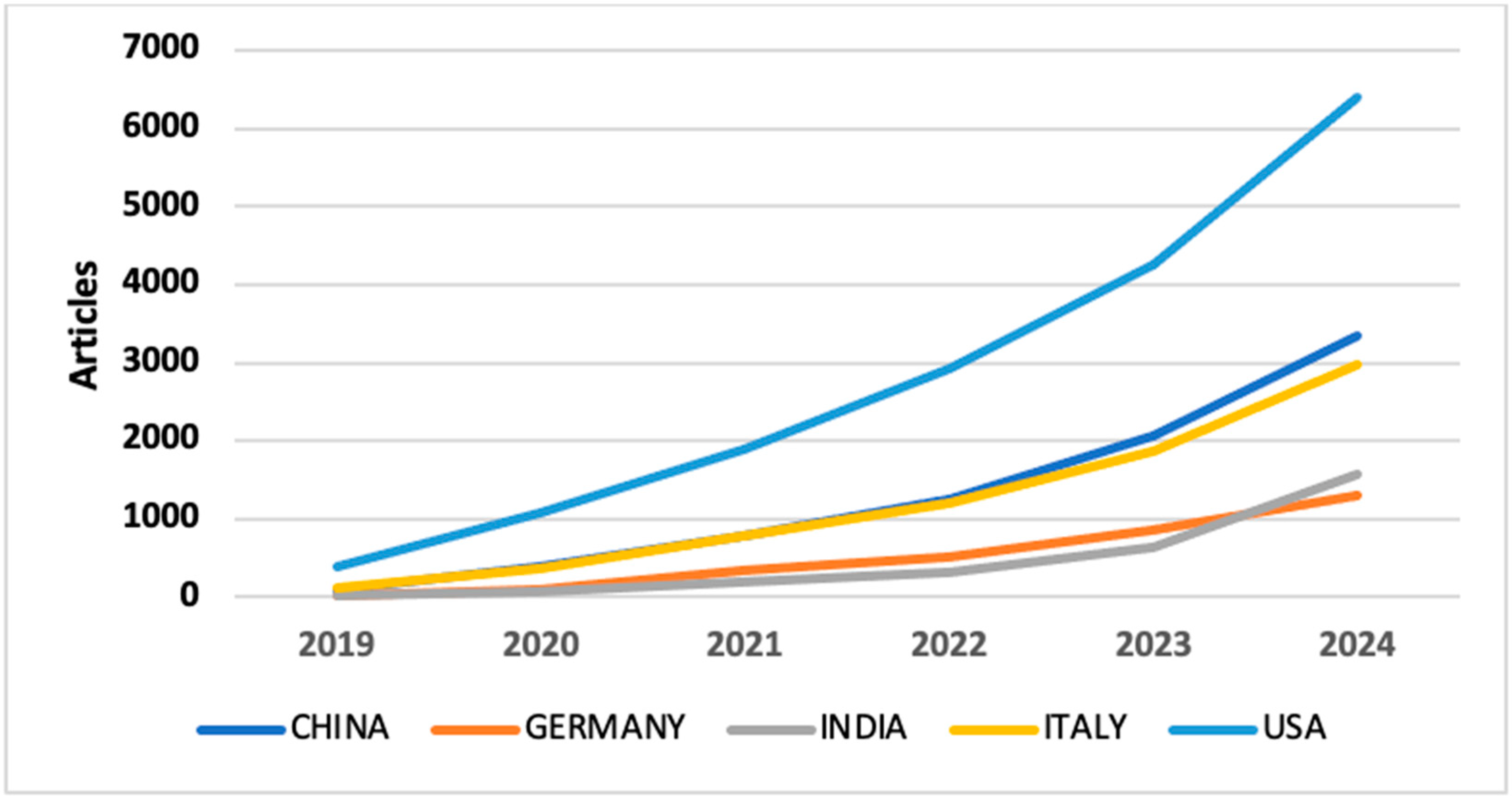
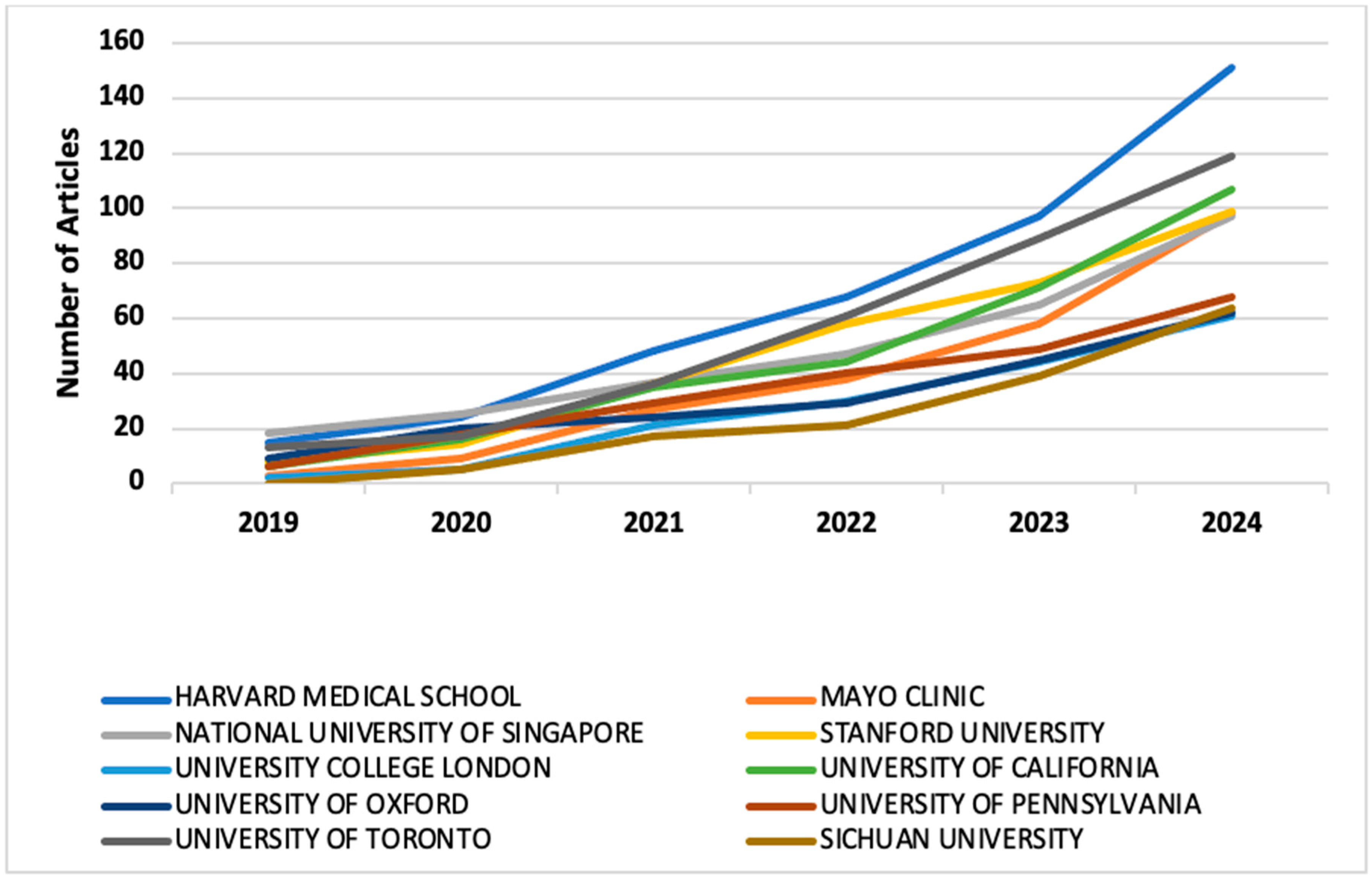
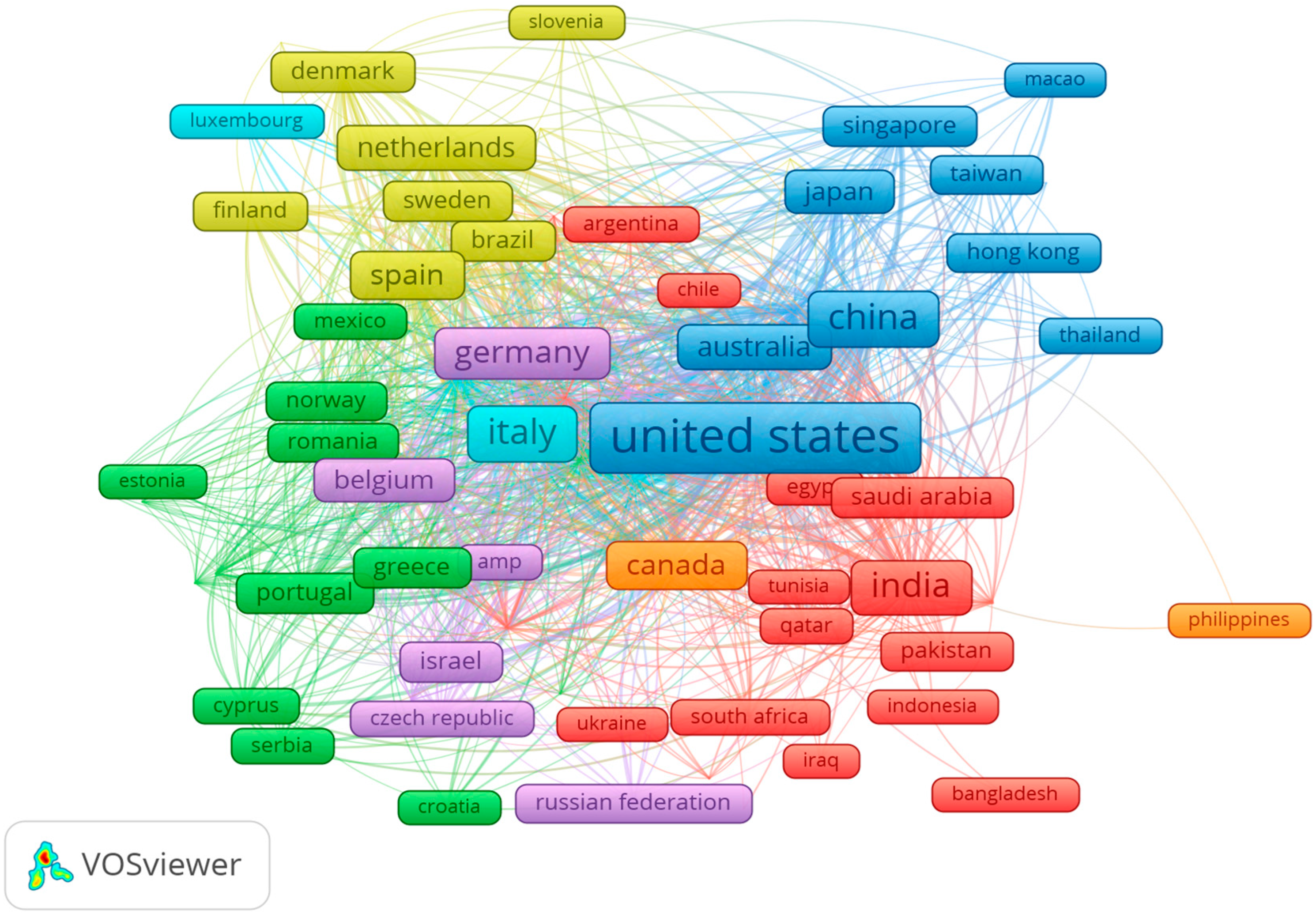

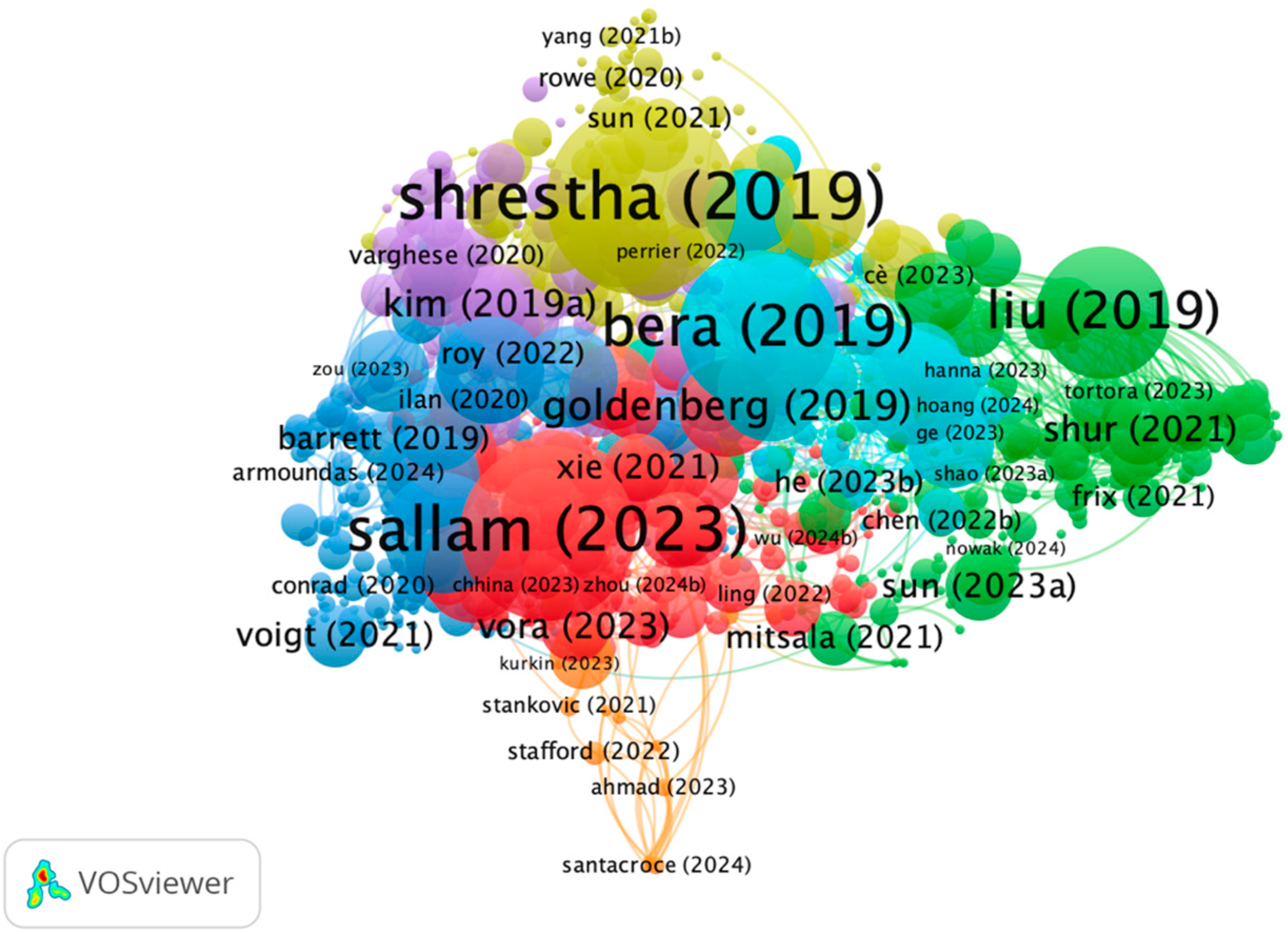

| Item | Value |
|---|---|
| Publication years | 2019–2024 |
| Citation years | 2019–2024 |
| Papers | 4574 |
| Citations | 70,474 |
| Cites/year | 14,094.80 |
| Cites/paper | 15.41 |
| Cites/author | 19,247.52 |
| Papers/author | 1469.43 |
| Authors/paper | 4.97 |
| h-index | 110 |
| g-index | 180 |
| Year | Articles | % of Total | % Growth from Previous Year |
|---|---|---|---|
| 2019 | 280 | 6.12% | — |
| 2020 | 420 | 9.18% | +50% |
| 2021 | 604 | 13.20% | +43.8% |
| 2022 | 646 | 14.12% | +6.95% |
| 2023 | 1055 | 23.06% | +63.3% |
| 2024 | 1569 | 34.30% | +48.7% |
Disclaimer/Publisher’s Note: The statements, opinions and data contained in all publications are solely those of the individual author(s) and contributor(s) and not of MDPI and/or the editor(s). MDPI and/or the editor(s) disclaim responsibility for any injury to people or property resulting from any ideas, methods, instructions or products referred to in the content. |
© 2025 by the authors. Licensee MDPI, Basel, Switzerland. This article is an open access article distributed under the terms and conditions of the Creative Commons Attribution (CC BY) license (https://creativecommons.org/licenses/by/4.0/).
Share and Cite
Adam, K.M.; Ali, E.W.; Elangeeb, M.E.; Abuagla, H.A.; Elamin, B.K.; Ahmed, E.M.; Edris, A.M.; Ahmed, A.A.E.M.; Eltieb, E.I. Intelligent Care: A Scientometric Analysis of Artificial Intelligence in Precision Medicine. Med. Sci. 2025, 13, 44. https://doi.org/10.3390/medsci13020044
Adam KM, Ali EW, Elangeeb ME, Abuagla HA, Elamin BK, Ahmed EM, Edris AM, Ahmed AAEM, Eltieb EI. Intelligent Care: A Scientometric Analysis of Artificial Intelligence in Precision Medicine. Medical Sciences. 2025; 13(2):44. https://doi.org/10.3390/medsci13020044
Chicago/Turabian StyleAdam, Khalid M., Elshazali W. Ali, Mohamed E. Elangeeb, Hytham A. Abuagla, Bahaeldin K. Elamin, Elsadig M. Ahmed, Ali M. Edris, Abubakr A. Elamin Mohamed Ahmed, and Elmoiz I. Eltieb. 2025. "Intelligent Care: A Scientometric Analysis of Artificial Intelligence in Precision Medicine" Medical Sciences 13, no. 2: 44. https://doi.org/10.3390/medsci13020044
APA StyleAdam, K. M., Ali, E. W., Elangeeb, M. E., Abuagla, H. A., Elamin, B. K., Ahmed, E. M., Edris, A. M., Ahmed, A. A. E. M., & Eltieb, E. I. (2025). Intelligent Care: A Scientometric Analysis of Artificial Intelligence in Precision Medicine. Medical Sciences, 13(2), 44. https://doi.org/10.3390/medsci13020044





